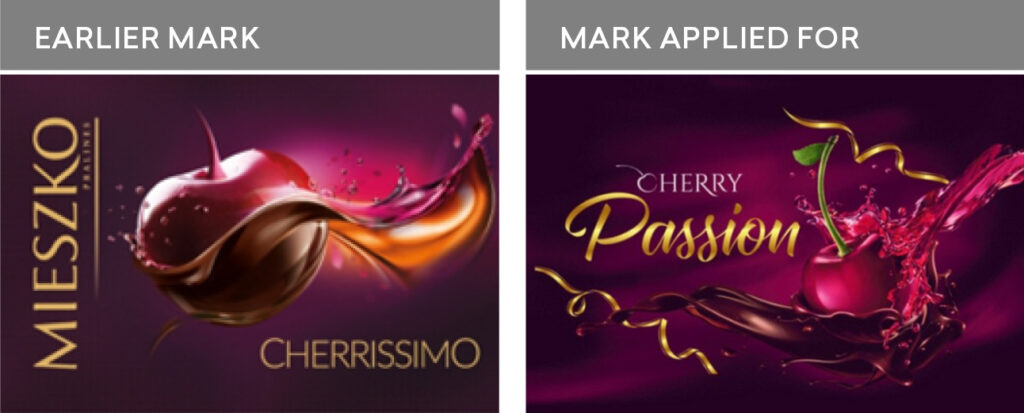In case T‑29/23 (Vobro/Mieszko), the General Court of the EU (GCEU) was asked to rule on the likelihood of confusion (LoC) of two complex signs containing word elements and the image of a cherry dipped in chocolate in relation to class 30 goods (confectionery and sweets).
Summary of the decision
After the EUIPO Opposition Division had rejected the opposition finding there was no LoC, the EUIPO Board of Appeal (BoA) annulled this decision finding there was LoC. By a judgment of 29 November 2023, the GCEU confirmed the BoA’s decision on the grounds that:
- the goods in question are everyday consumer goods aimed at the general public and which could be low in price so that the relevant public’s level of attention is low;
- the overall composition and structure of the signs at issue are extremely similar. Where a mark is composed of word and figurative elements, the figurative elements could have the same importance, or even more importance, than the word elements (even though, in principle, word elements are more distinctive than figurative elements).The reproduction and specific arrangement of the elements of the earlier sign as well as the colours used – more specifically the elegant combination of purple nuances in the background, which becomes lighter towards the centre in order to give greater prominence to the depiction of a cherry dipped in chocolate, which in turn combines various shades of orange, brown, pink and purple – has, taken together, a substantial impact on the appearance of the sign as a whole and could not be disregarded in the overall comparison. On the whole, the cherry images in the marks are highly similar since both signs feature a realistic depiction of a cherry dipped in chocolate which, to the right of the cherry, turns into a liquid of various shades;
- goods which are generally sold side by side in supermarkets, department stores and other similar retail outlets are marketed in such a way that the relevant public usually perceives visually the mark designating those goods. Where the marks at issue are examined at the distance and speed at which the consumer, in a supermarket, selects the goods they are looking for, the differences between the signs at issue are more difficult to distinguish and the similarities are more apparent, since the average consumer perceives the mark as a whole and does not proceed to analyse its various details. This principle of imperfect recollection is of particular importance, given the low level of attention of the relevant public. That fact gives more weight to the elements which are particularly visible and easy to apprehend in the marks concerned such as, in this case, the figurative elements of the marks at issue.
- as regards foodstuffs which are most often purchased in supermarkets, the visual and figurative aspect is of greater importance, which increases the LoC between the marks at issue. The fact that the packaging of other goods may contain representations of a cherry dipped in chocolate which are similar to those in the marks at issue does not in any way detract from the finding that those marks resemble each other in that regard;
- the earlier mark has a highly distinctive character in Poland for cherry-flavoured chocolate pralines and boxes of chocolates with a cherry flavour. The mark applied for reproduces the visual essence of the earlier mark, which enjoys enhanced distinctiveness, giving rise to a LoC on the part of the relevant Polish public with a low level of attention in relation to goods that are identical or similar to varying degrees.
Comment
This judgment of the GCEU applies the EU Court of Justice’s case law in a.o. La Española (T‑363/04 and C‑498/07) and gives trademark owners additional ammunition to challenge the use of ‘lookalike’ packaging for identical or similar everyday consumer goods, which is a common practice by discount supermarkets.
If you want to know more about this case or about IP protection/ enforcement in general, please contact michael.devroey@simontbraun.eu.
Download PDF version here
***
This newsletter is not a legal advice or a legal opinion. You should seek advice from a legal counsel of your choice before acting upon any of the information in this newsletter.

